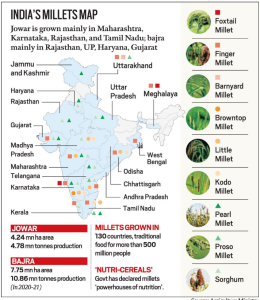Discuss about the Millets
Millets
Why in news?
The Food and Agriculture Organization of the United Nations (FAO) has declared 2023 as the International Year of Millets.
About Millets
- They are fundamentally grasses. They are cultivated worldwide, but especially in the tropical parts of Africa and Asia, as cereal crops.
- Some of the more common varieties include pearl millet (Cenchrus americanus), barnyard millet (Echinochloa utilis), finger millet (Eleusine coracana), and foxtail millet (Setaria italica)
- There is both palaeontological and textual evidence to indicate that millets were being cultivated in the Indian subcontinent five millennia ago.
- According to the Agricultural and Processed Foods Development Authority, India is the world’s largest producer of millets.
- In 2021-2022, the country accounted for 40.51% of the world’s pearl millet production and 8.09% of sorghum.
- Within the country, pearl millet made up 60% of all the millet production, sorghum 27%, and ragi 11%.
- Sorghum (Sorghum bicolor), adlay millet (Coix lacryma-jobi), and teff (Eragrostis tef), among others, are grasses that differ in some respects from millets but are grouped together with them
- Millets have two broad features that render them attractive —
- their nutritional value being comparable to that of major extant food crops (and better on some counts) and
- their ability to reliably withstand harsh, resource-poor conditions
Resilient Food
- They are drought-tolerant, adapted to growing in warm weather, and require low moisture (axiomatically, they are particularly efficient consumers of water) and loamy soil. They don’t grow well in water-logged or extremely dry soil which might occur after heavy rainfall or particularly bad droughts, respectively
- According to the M.S. Swaminathan Research Foundation, millets also “thrive on marginal land in upland and hilly regions”; marginal land is land whose rent is higher than the value of crops that can be cultivated there

- The nutritional content of millets include carbohydrates, proteins, fibre, amino acids, and various minerals
- Different millet varieties have different nutrient profiles. For example, pearl millet — one of the oldest cultivated varieties — has been found to have higher protein content than rice, maize, and sorghum, while being comparable to that of barley
- According to various studies, foxtail millet is rich in the amino acid lysine; finger millet has more crude fibre than wheat and rice; proso millet has a significant amount of the amino acids leucine, isoleucine, and methionine; and overall, millets have been found to be important sources of micronutrients and phytochemicals
- each millet kernel consists of three major parts, called pericarp, endosperm, and germ. The pericarp has an outer covering called the husk. The husk and the pericarp together protect the kernel from inhospitable conditions, disease, and physical damage
- The endosperm is the largest part of the kernel and its ‘storage’ centre. It has a protein covering called the aleurone. According to an FAO article about sorghum, the endosperm is “relatively poor in mineral matter, ash and oil content” but “a major contributor to the kernel’s protein (80%), starch (94%) and B-complex vitamins (50-75%)”
Women at Workplace (Prevention, Prohibition and Redressal) Act, (PoSH Act)
Why in news?
More than 50% of India’s Sports Federation lacks Internal Complaints Committee
About the Act
- Women at Workplace (Prevention, Prohibition and Redressal) Act, 2013 (PoSH) came into force, the Supreme Court Bench of India (Vishakha guidelines) has said there are “serious lapses” and “uncertainty” regarding its implementation
- PoSH Act defines sexual harassment to include unwelcome acts such as physical contact and sexual advances, a demand or request for sexual favours, making sexually coloured remarks, showing pornography, and any other unwelcome physical, verbal or non-verbal conduct of a sexual nature
- Under the Act, an employee is defined not just in accordance with the company law. All women employees, whether employed regularly, temporarily, contractually, on an ad hoc or daily wage basis, as apprentices or interns or even employed without the knowledge of the principal employer, can seek redressal to sexual harassment in the workplace
- The law expands the definition of ‘workplace’ beyond traditional offices to include all kinds of organisations across sectors, even non-traditional workplaces
- It applies to all public and private sector organisations throughout India
- The law requires any employer with more than 10 employees to form an Internal Complaints Committee (ICC) which can be approached by any woman employee to file a formal sexual harassment complaint. It has to be headed by a woman, have at least two women employees, another employee, and a third party such as an NGO worker with five years of experience, familiar with the challenges of sexual harassment.
- District Officer to constitute Local Committee to receive complaints from organisations with less than 10 workers or if complaint is against the employer itself.
- Act mandates every district in the country to create a local committee to receive complaints from women working in firms with less than 10 employees and from the informal sector, including domestic workers, home-based workers, voluntary government social workers and so on
- The employer has to file an annual audit report with the district officer about the number of sexual harassment complaints filed and actions taken at the end of the year.
PoSH – Prevention of Women from Sexual Harassment
